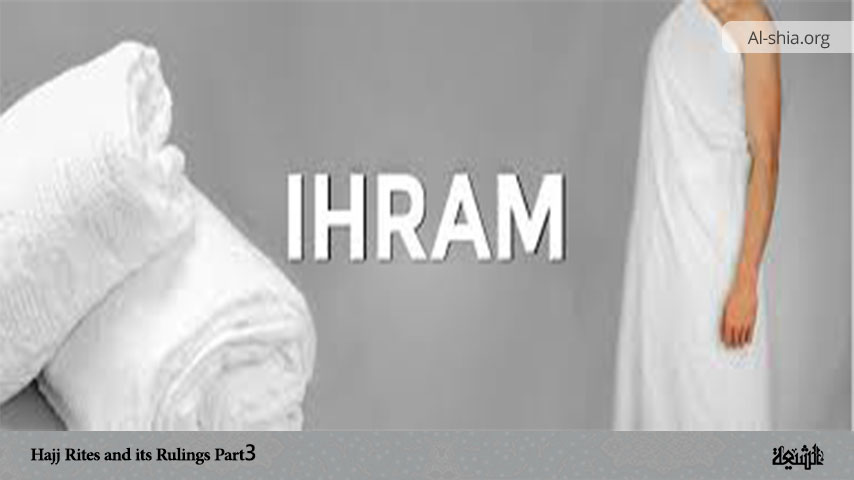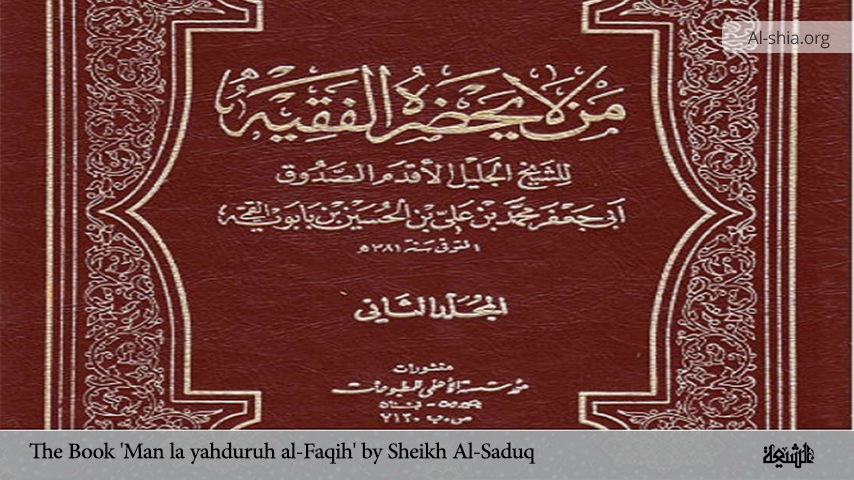In continuation of the selected rulings on Hajj rites based on the religious verdicts (Fatwas) of His Eminence, Grand Ayatollah Sistani (May his authority be prolonged), we shall be discussed some selected rulings related to Ihram as follows:
The three obligations of Ihram are: Intention (Niyyah), Talbiyyah and wearing ihram garments. Some details on each of them shall be given as follows:
First: An Intention (Niyyah)
That is, the pilgrim makes up his mind to perform what is obligatory on him by way of Umrah and Hajj to attain proximity to Allah. If he does not know all the ceremonies in detail, he must establish the intention generally. In such a case, it is obligatory that he knows what is required of him gradually, by referring to the Manual, or by checking with a learned person he trusts.
Meanwhile, a sound intention should cater for the following:
i) That the intention must be to attain nearness to Allah, as is the case in other acts of worship;
ii) That the intention must be made at the designated places for the wearing of the Ihram for Umrah or Hajj, and whether for Hajj-ut-Tamatu, Qirān or Ifrād.
iii) If Umrah or Hajj was on behalf of someone else, such intention must be clearly made.
iv) Whoever wishes to perform a pilgrimage to fulfil a vow must perform the ceremonies to accomplish the vow without any need to state expressly the intention of any of such types of pilgrimage as: (a) a vow for oneself or on behalf of another, (b) Hajjatul Islam, (c) to fulfil a vow, and (d) obligatory as a penalty or optional.
v) If the intention is made without specifying the type of pilgrimage, the ihram will be invalid.
Rule 1: It is not necessary for the validity of intention to be uttered loudly or notionally. It is sufficient that it is consciously formed as is the case in other acts of worship.
Rule 2: It is not a requirement for the validity of the ihram that there should be a determination to refrain from all the prohibitions from the moment it is worn till its removal. However, if the pilgrim was intent, from the outset of Umrat-ul-Mufradah, on having sex with his wife before completing sa’y, or he wavered, his ihram will, evidently, be void. The same applies to masturbation, as a matter of precaution. Yet, if, from the outset of wearing the ihram, he was intent on refraining from such acts, but after wearing the ihram, he changed his intention to committing either of them, the ihram is not vitiated.
Second: Talbiyah
That is, to utter the following: “Labbaik, Allahumma Labbaik, Labbaik, la sharika laka labbaik”, (meaning “Here I am! at Your service, O Lord! Here I am! at Your service, You have no partner. Here I am at Your service.”).
It is highly recommended to add the following: “Inna al-hamda wanni’amata laka wal mulk, la sharika laka”. It is permissible to add “Labbaik” and say, “La sharika laka labbaik”, (meaning “All the praise is Yours, so is the bounty, and to You belongs the property; there is no partner to You. Here I am! at Your service.”).
Rule 1: Every pilgrim must learn the proper pronunciation of the words of the Talbiyah and recite them correctly just as the recitation of Takbiratul ihram in prayer. This should be achieved, even if it is by following another person reciting these words. If a person does not have the proper pronunciation of the words nor is there a person whom he can follow, he is still obliged to recite the words as best he can, unless his recitation is such that it is not considered to be Talbiyah. In such a situation, he should, as a matter of precaution, recite as much as he can of it, recite the translation of the Talbiyah and appoint an agent to recite it on his behalf.
Rule 2: A person who becomes dumb as a result of disease or injury should recite Talbiyah as much as he can, and if he is unable to recite it, he must move his tongue and lips while he is making intention, and make gestures by fingers in tandem with the recitation. A person born dumb should move his tongue and lips as if he is reciting and make gestures with his fingers as well.
Rule 3: Another person must recite Talbiyah for a child not capable of rational action (ghayr mumayyiz).
Rule 4: The ihram for Hajj-ut-Tamatu’, Umrat-ut-Tamatu’, Hajj-ul-Ifrād or Umrat-ul-Mufradah is not complete without Talbiyah.
Rule 5: Purity from urine or excrement is not a condition for the validity of the ihram. Thus, a person can wear an ihram even in the condition of janabah, haydh, nifas or the like.
Rule 6: For Qirān, the position of Talbiyah in ihram is that of Takbirat-ul-ihram in prayers, ihram is not complete without it. Therefore, if a person had made the intention for ihram and wore the two pieces of cloth but, before reciting the Talbiyah, performed one of the acts prohibited during ihram, he had not done any wrong and he would not incur any kaffarah.
Rule 7: The obligation is to recite Talbiyah once; it is though mustahab to repeat it as many times as one possibly can. As a matter of precaution, a person performing Umrat-ut-Tamatu’ must stop the recitation of Talbiyah on sighting the houses of old Makkah. The point for those arriving at Makkah, via its upper approaches, from the route of Madinah is Madniyeen. The point for those arriving via its lower approaches is Aqabat Thi Tawa. As a matter of precaution too, those performing Umrat-ul-Mufradah must stop the recitation on entering the Haram, if they have arrived from outside Makkah. Those who have gone outside Makkah, only to wear the ihram from Adnal Hil, should cease the recitation on sighting the Holy Ka’aba. Those performing all types of Hajj must stop the recitation at Zawaal (noon) on the day of Arafat.
Rule 8: If after wearing the two pieces of cloth for ihram but before departing from the Meqat, a person entertains a doubt as to whether or not he had recited the Talbiyah, he should recite it; if the doubt arises after the recitation as to whether he had recited it correctly, he should resolve that he had.
Third: Wearing ihram garments
After taking off all that which is not permitted to wear during ihram, it is obligatory to wear the two pieces of ihram. Children are exempt from this rule as they can delay wearing ihram till Fakh if they take that route. Apparently, there is no certain way of wearing them. So, one can wear one of the pieces of cloth around the waist in whatever way he wishes and place the other piece over the shoulders, or use it as a robe. However, as a matter of precaution, the two pieces should be worn in the traditional way.
Rule 1: Most evidently, wearing the two pieces of cloth is obligatory as a matter of obedience in worship, yet it is not a condition for the validity of the ihram.
Rule 2: As a matter of precaution, it is necessary that the piece of cloth worn round the waist should cover the portion from the navel to the knee; the other piece should cover both the shoulders, arms and a considerable part of the back. As a matter of obligatory precaution, both the pieces must be worn before the intention and Talbiyah. If the intention and Talbiyah precede the wearing of the ihram, the pilgrim must repeat both, after wearing the ihram, as a matter of preferential precaution.
Rule 3: If through ignorance or oversight, the ihram is worn over a shirt, the shirt must be removed immediately and the ihram is valid. Indeed, most evidently, the ihram is valid even, if the shirt was worn deliberately. However, if it is put on after wearing the ihram there is no doubt that the ihram will be valid; however, the shirt must be removed from below.
Rule 4: There is no objection to having more than the two pieces of cloth in ihram at the time of wearing it, or afterwards, for protection against heat or cold or any other reason.
Rule 5: The conditions applied to the garments of ihram are the same as those applied to clothes worn in prayers. It is necessary that they should not be made of pure silk, gold, or products of wild animals. And, as a matter of precaution, they should not be made of parts of the body of an animal whose meat is forbidden. Both the pieces must be pure (clean, not najis).
Rule 6: As a matter of precaution, the garment worn round the waist be of a quality capable of concealing the body, not a revealing one. This is not a must for the garment used round the shoulders.
Rule 7: As a matter of optional precaution, both the pieces must be of textile, and not of leather, for example.
Rule 8: The obligation to wear the two pieces round the waist and the shoulders is confined to males only and does not apply to females who may wear as ihram their usual clothes, provided that they comply with the conditions stated above.
Rule 9: Although forbidding the wearing of silk is generally confined to males, it, as a matter of precaution, also applies to females insofar as ihram is concerned, in that they should refrain from wearing anything made of pure silk throughout the period of ihram. The only exception is in the case of necessity, as for protection from cold or heat.
Rule 10: If either or both garments worn for ihram become impure (najis), it or they, as a matter of precaution, must be changed or rendered pure (Tahir) as soon as possible.
Rule 11: It is not obligatory to have the clothes of ihram on all the time. There is no objection to its removal, whether necessary to do so or not. Nor is there any objection to changing them, provided the other pair complies with the conditions stated above.

















